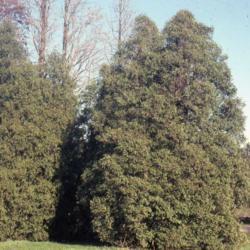While this plant is useful as a screen, it provides very few other benefits to the garden. That being said, birds do use it for perching and nesting. It is way too overplanted and will split under heavy snow or ice loads if above 10-12' tall. My rear neighbor lined his property with these when he moved in about 35 years ago. They're still around, but they look pretty haggard. If properly trimmed and maintained every couple years, a hedge of this plant can look nice without becoming an eyesore.

The 'Green Giant' Western Arborvitae is commonly planted in the Mid-Atlantic and Midwest of the US. It gets larger than the cultivars of the Eastern or American Arborvitae, not the mother species, and its advantage over the eastern species is that deer don't like to eat the very waxy scaly foliage, while deer love to eat the lower parts around the eastern species.

The American or Eastern Arborvitae or Whitecedar, Thuja occidentalis, is a northern species native to southern Ontario & Quebec up almost to Hudson Bay, to Nova Scotia, northern New England & New York, northern Michigan, northern Wisconsin, and northern Minnesota, growing mostly in swamps, bogs, and lake margins, but also grows in open rocky meadow and hillsides. It has soft, fan-like, scaly, sort of aromatic foliage and it bears small erect, egg-shaped cones of 8 to 12 scales. It grows about 1 to 2 feet/year and often lives over 400 years. Its shallow, fibrous root system makes it easy to transplant. I saw some way up in northern Minnesota in a swamp many years ago while on vacation. Otherwise, I have only seen the regular or straight or mother species at Morton Arboretum in northeast Illinois, west of Chicago planted near the little Du Page River. Numerous cultivars that are compact and dwarf with various characteristics have been taken from this species and are abundantly planted in landscapes in much of eastern North America.

Native in the Pacific NW from Alaska to northern California, east to Alberta, Idaho, and Montana. Found in moist or swampy areas from sea level to mid-elevations. Stately large tree, grows fairly quickly. Makes for a good climbing tree. The name of my neighborhood is 'Cedarhome' and we have many cedar trees in our back woods.

There was a period in Oklahoma City's gardening history when lots of gardeners were trying their best to grow Lombardy Poplars and/or Italian Cypress. Eventually they realized these two plants just were not suited to life on the southern Great Plains. Then, somewhere in the 1980's, nurserymen here were able to recommend an American Arborvitae named 'DeGroot's Spire'... and gardeners began to achieve success with an almost extremely fastigate plant.

Amber Glow is a miniature variety of Eastern Arborvitae. It prefers well drained soil and its growth averages about 1 inch a year. It has glowing gold overlaid foliage and is evergreen. Great plant for a rock garden.

In the Chicago region, the Mission Arborvitae, 'Techny', a cultivar discovered at a monastery in Techny, IL, has been a popular compact selection for several decades. It becomes a broad pyramidal form that holds green colour through the winter and it gets about 8 to 10 feet high by 5 to 6 feet wide in most landscape estimations, though it can eventually get to 15 feet high after many years.
